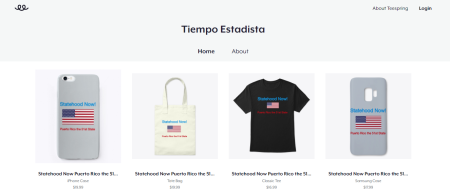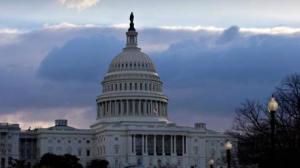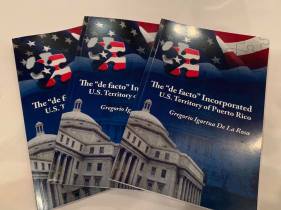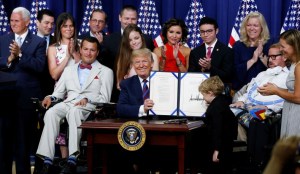Si deseas ir a la tienda online de Tiempo Estadista puedes dar click al siguiente link:
https://teespring.com/stores/tiempo-estadista

LINK O VINCULO A LA TIENDA TIEMPO ESTADISTA
Si deseas ir a la tienda online de Tiempo Estadista puedes dar click al siguiente link:
https://teespring.com/stores/tiempo-estadista

LINK O VINCULO A LA TIENDA TIEMPO ESTADISTA
“Trump noted to GOP senators that Texas — also battered by a spate of hurricanes — was awarded $29 billion in aid, while South Carolina got $1.5 billion to recover from storms. Trump then questioned why Puerto Rico was getting $91 billion, according to two people familiar with his comments, indicating that this was too much compared with compensation for states on the mainland.”
— The Washington Post, March 26, 2019
President Trump has been complaining about the cost of the recovery effort for Puerto Rico after Hurricane Maria. In a private meeting with Republican senators he tossed out a number — $91 billion.
The figure is significantly higher than what is known about appropriated funds for Puerto Rico. But administration officials say he has a basis for using it.
Let’s explore.
Getting a full picture on federal government spending for Puerto Rico so far is difficult because it’s spread across different agencies and spending bills. But here’s the best possible estimate we received, as of March 27, after communications with officials in different agencies.
That adds up to nearly $41 billion in announced funding. But notice words like “obligated” and “outlays”?
Here’s an explanation:
About half of the money scheduled for Puerto Rico comes from the HUD grants. But virtually none of that funding has been spent yet. HUD in July said it had approved spending $1.5 billion but the funds had not been drawn down yet, according to a Government Accountability Office reportreleased this month. About 50 percent has been earmarked for home repair and reconstruction.
A HUD official said Puerto Rico has the $1.5 billion in hand, but has spent just $42,000. “It should take Puerto Rico approximately two to three years to spend the $1.5 billion,” the official said. “Following Superstorm Sandy, the state of New Jersey disbursed $1 billion over the course of two years.”
Another $8.2 billion of the $20 billion HUD allocation was approved in February but not yet delivered. That still leaves about half of the $20 billion untouched.
In other words, depending on how you do the math, only about a quarter of the total pot of money has actually been spent on the island — $11.2 billion.
So how does Trump come up with $91 billion?
Officials told The Fact Checker that the president was referring to an internal Office of Management and Budget estimate of the potential liabilities over the life of the disaster that would need to be committed under the Robert T. Stafford Disaster Relief and Emergency Assistance Act of 1988. The estimate was described as a high-end estimate subject to change year by year.
Currently, the estimated Stafford liabilities amount to $50 billion. Adding the $41 billion in announced funding to the $50 billion in Stafford liabilities gets you to $91 billion.
Notice that we said the additional $50 billion was “over the life of a disaster.” That means it’s a long-term figure, beyond the traditional 10-year budget horizon. Indeed, one congressional aide estimated that Stafford payments will continue for 20 years in Puerto Rico. The government is still paying for the damage from Hurricane Katrina almost 14 years after it struck New Orleans.
Texas has been allocated $25 billion, but its estimated Stafford liabilities are much smaller — just $4 billion, according to the OMB estimate. Together, that adds up to $29 billion.
What apparently caught Trump’s attention was the relative scale — with the estimated long-term cost of Puerto Rican repairs potentially three times larger than the cost of Hurricane Harvey in Texas.
The Pinocchio Test
Without a direct, verified quote, we cannot evaluate the accuracy of the president’s statement. His remarks were interpreted by senators as money already committed or spent. But administration officials said he was talking about future liabilities, especially in relative terms to other recent disasters.
The president sometimes speaks about future spending as if it’s already taken place. But if he’s comparing various Stafford estimates, it could be reasonable to use 20-year figures as long as he indicated that this did not reflect current obligations. (Update: On March 28, Trump put it this way in remarks to reporters: “We have $91 billion going to Puerto Rico. We have $29 billion to Texas and $12 billion to Florida for the hurricanes.” He did not indicate that he was talking about long-term, 20-year estimates.)
But at least now the mystery is solved about the source of the $91 billion number.
Si deseas comprar camisas, carcasas de celular, tasas de cafe o stickers

LINK O VINCULO A LA TIENDA TIEMPO ESTADISTA

Por la presente anuncio que Tiempo Estadista da a conocer el lanzamiento oficial de nuestra tienda online en donde se podran adquirir Camisetas, tasas, carcasas de celular (cases), stickers entre otros. Todos los articulos responderan a los valores y causas por las cuales Tiempo Estadista es reconocido que son la defensa de la estadidad los valores y el conservadurismo americano.
Antonio Velazquez creador y administrador del blog Tiempo Estadista es el creador de esta tienda online. Le exortamos a que auspicien la tienda y compren a su gusto. Recuerden que no solo auspician la causa estadista sino que tambien apoyan a Antonio Velazquez en su trabajo ideologico.
Para accesar la tienda podran hacerlo atravez del link o vinculo abajo, de ahora en adelante en todas nuestras publicaciones futuras del blog Tiempo Estadista tendra un link similar para accesar facilmente la tienda.
LINK O VINCULO A LA TIENDA TIEMPO ESTADISTA
https://teespring.com/stores/tiempo-estadista

Washington.- Un grupo de legisladores de la Cámara de Representantes del estado de Washington ha presentado una medida que busca una expresión de apoyo a la incorporación de Puerto Rico como territorio de Estados Unidos.
La integración a Estados Unidos, aunque necesaria para caminar hacia la estadidad, no supone otorgar automáticamente la estadidad a Puerto Rico advierte la resolución.
La medida, presentada por el republicano Dan Stokesbary y otros 16 legisladores estatales, advierte que como territorio no incorporado, Puerto Rico no tiene acceso al trato igual bajo las leyes federales, como el acceso a la Seguridad de Ingresos Suplementarios (SSI), y otros programas de bienestar social.
Como territorio incorporado, aunque no tendría los derechos políticos de un estado (como votar por el presidente de EE.UU. y tener plena representación en el Congreso), los residentes de Puerto Rico tendrían que pagar contribuciones federales sobre ingresos.
“La negativa de Estados Unidos a otorgar trato igual a los residentes de Puerto Rico bajo ciertas leyes federales se justifica únicamente sobre la base de que Puerto Rico no está incorporado a la Estados Unidos, a pesar de más de cien años de asimilación en la cultura, la economía y el proceso político de los Estados Unidos”, indica la medida legislativa presentada el lunes en la Cámara baja estatal.
La medida propone enviar copia de la resolución al presidenteDonald Trump y al liderato del Congreso.
“Este es un asunto de igualdad. Puerto Rico ha votado dos veces en los últimos siete años para convertirse en parte de nuestra gran nación”, indicó Stokesbary, en un comunicado de prensa.
La más reciente legislación pro estadidad de la comisionada residente enWashington, Jenniffer González, propuso también incorporar a la isla como territorio y entonces crear un Grupo de Trabajo del Congreso que estudiara los cambios a las leyes que son necesarios para convertir a Puerto Rico en el estado 51.
Mañana, las autoridades de Washington D.C. llevarán a cabo en el Congreso el día a favor de la estadidad para la capital estadounidense, para promover el proyecto de admisión como estado que tiene el respaldo de 195 demócratas de la Cámara de Representantes.


Presentación del libro The “de facto” Incorporated U. S. Territory of Puerto Rico por el abogado Lic Gregorio Igartua. En el libro Igartua establece que el Congreso debe de clasificar ya a Puerto Rico como un territorio incorporado con grandes beneficios para Puerto Rico.
The GOP Is Making Health Care Great Again
By Deroy Murdock, National Review

October 26, 2018 U.S. President Donald Trump shows off the signed “Right to Try Act,” which gives terminally ill patients the right to use experimental medications not yet been approved by the Food and Drug Administration. (REUTERS/Leah Millis )
While Obamacare has been neither repealed nor replaced, it is being superseded. As President Donald Trump said, “We will deliver relief to American workers, families, and small businesses, who right now are being crushed by Obamacare, by increasing freedom, choice, and opportunity for the American people.”
The total number of Americans with health insurance rose from 292.3 million in 2016 to 294.6 million in 2017, the Census Bureau reports. Some of the following new reforms have helped 2.3 million more Americans enjoy medical coverage and alternatives under Republican leadership rather than Democrat mismanagement.
Republicans last December “ended the unfair individual-mandate penalty” under Obamacare, President Trump observed. “People are paying a lot of money for the privilege of not paying a lot of money for bad health care. And we’ve ended it.” Every single Democrat in Congress opposed individual-mandate repeal, which was part of the Tax Cuts and Jobs Act.
Trump signed legislation in February to repeal the Independent Payments Advisory Board, also known as the “Death Panel,” that would have rationed Obamacare. IPAB is dead and threatens no one.
As promised, Trump signed the Right to Try Act on May 30. Terminally ill Americans who have exhausted other options now are free to use drugs that have passed the FDA’s Phase 1 safety trials but not yet passed effectiveness tests. The FDA’s “compassionate use” program only helped some 1,200 patients annually, the White House estimates. It added: “‘Right to Try’ gives the over 1 million Americans who die from a terminal illness every year a new tool to fight and make potentially lifesaving decisions about their treatment.”
“People who are terminally ill should not have to go from country to country to seek a cure,” Trump said. “I want to give them a chance right here at home.”
The U.S. House’s roll call on this measure showed the parties’ true colors.
All 228 Republicans present voted for the Right to Try on May 22. But only 22 Democrats voted yes. The other 169 voted to deprive terminally ill Americans of the experimental drugs that might keep them alive. California’s Nancy Pelosi and Maxine Waters, Maryland’s Steny Hoyer, and New York’s Jerrold Nadler were among the pharmo-totalitarians who did not let even these imminent deaths tame their lust to control others.
The Trump administration in June authorized “association health plans.” Entrepreneurs, small employers, and civic organizations (e.g., the Las Vegas Metro Chamber of Commerce and the Small Business Association of Michigan) now may join hands and insure their employees and members, including across state lines.
Last summer, the administration extended the duration of short-term, limited health plans from three months to one year, with renewals permitted up to three years. In essence, Team Trump increased twelve-fold the allowable length of short-term policies. “For example, according to E-Health, the average lowest premium for an Obamacare plan for a 40-year-old woman is about $4,200 per year,” Trump noted. “By contrast, the average lowest premium for short-term coverage for this individual is about $1,300 a year — a savings of $3,000,” or 69 percent off.
These plans are cheaper because they lack many of Obamacare’s costly, needless, and foolish mandates. Every Obamacare plan must include pediatric vision coverage — even if the policy holder is childless, sterile, and mortally terrified of small, screaming objects.
The GOP’s cost-cutting, liberty-expanding dynamic contrasts vividly with the Democrats’ cruel, truncheon-wielding approach. As Health Secretary Alex Azar wrote in the Washington Post on August 15: “Such plans were offered for terms of up to 12 months for decades until, in an effort to push Americans into Obamacare, the previous administration restricted the plans to 90 days and prohibited insurers from renewing them beyond that time period.”
The administration in August required hospitals to post the prices of their procedures online and update them annually. Patients will be able to shop around when deciding where to get treated. Such competition should slow or even counteract medical-cost inflation.
The president this month signed two bills that increase drug-price transparency. “Our great citizens deserve to know the lowest price available at our pharmacies,” he said. “They’ll be able to see pricing. … And as they start leaving certain pharmacies, those pharmacies will be dropping their prices.”
The administration opposes “gag clauses” in Medicare Part D plans. Pharmacists now are free to tell patients about money-saving prescription-drug options.
President Trump has turned the FDA’s red lights green. “We’ve massively sped up the FDA approval process,” he said October 10. “Last year, the FDA approved more than 1,000 low-cost generics — the most in its history … saving America almost $9 billion in the first year of my administration.”
“We have approved seven state waivers that provide federal assistance to help states pay for the sickest patients and allow insurers to keep premiums lower, all without increasing taxpayer burden,” Seema Verma, administrator of the Centers for Medicare and Medicaid Services (CMS), wrote last week. “These waivers appear to be working. For example, Wisconsinites will see their individual market premiums decrease by an average of 11 percent, due to the waiver.”
In an op-ed in Monday’s Wall Street Journal, Labor Secretary Alexander Acosta, Treasury Secretary Steven Mnuchin, and Health Secretary Alex Azar unveiled another option for patients. Employers will be liberated to offer workers tax-free Healthcare Reimbursement Arrangements. Employees could use HRA funds to cover qualified medical expenses. Employers who provide group coverage will be allowed to deposit up to $1,800 in each employee’s HRA annually.
Also, the secretaries wrote, “we would permit employers to offer HRAs to reimburse employees for health insurance purchased in the individual market.” This repeals a particularly ugly display of President Obama’s sadism. “In 2013, the Obama administration forbade employers from using HRAs or any similar arrangements to reimburse employees’ premiums for individual market coverage. That shut down an option many employers had used to assist employees in obtaining coverage.”
These reforms may explain the most startling development of all: Obamacare’s damage seems to be in remission. Average, annual, individual premiums on HealthCare.gov grew from $2,784 in 2013 to $5,712 in 2017 — a 105 percent hike. With Americans now enjoying greater freedom and choices, and insurers largely unshackled, Obamacare’s destruction is being reversed.
Comments
CMS reports that average Obamacare premiums will drop 1.5 percent in 2019, the first decline since this monstrosity took full effect in 2014. Rates are expected to fall 16 percent in Pennsylvania and 26 percent in Tennessee. According to the White House, 23 new insurers will enter the market next year. Today, 56 percent of counties in the federal exchange have only one insurer. Next year: 39 percent.
Ignore the Democrats. Republicans are making healthcare great again.
Freedom of speech
Freedom of speech is a principle that supports the freedom of an individual or a community to articulate their opinions and ideas without fear of retaliation, censorship, or sanction. The term “freedom of expression” is sometimes used synonymously but includes any act of seeking, receiving, and imparting information or ideas, regardless of the medium used.
CENSORSHIP ON SOCIAL MEDIA SHOULD NOT BE EMBRACED BY LIBERALS OR CONSERVATIVES IN GOVERMENT OR PRIVATE INSTITUTIONS. MORE FREEDOM IS THE ANSWER NOT LESS.